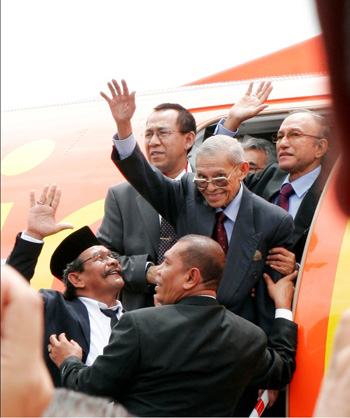The former rebels show an autocratic streak in their attempt to enthrone an absolute ruler
Gunnar Stange and Antje Missbach
 |
Hasan Tiro returns to Aceh prior to his death. Malik Mahmud is directly behind. |
The peace process in Aceh has been hailed as a great success internationally. Yet, in the years since the agreement was signed in Helsinki in 2005, a number of issues have arisen that could undermine peace. One of the biggest stumbling blocks is a controversy surrounding a pending local government law (qanun) on Aceh’s symbolic ‘head of state’ (Wali Nanggroe). The most hotly debated questions in this debate are whether the position should be a political or mostly symbolic one, and about what responsibilities should go with the office.
The debate reflects the strong desire of many Acehnese for symbols that reflect their unique cultural and religious heritage and their long-held desire for self-determination. But it also reveals deep insecurities regarding the question of what Acehnese identity is actually about. These insecurities became evident in late 2010 when there was public outrage about an attempt to enthrone Malik Mahmud, the former ‘Prime minister’ of GAM, the Free Aceh Movement, as the new Wali Nanggroe. The Aceh Party (Partai Aceh), the successor to GAM, was behind the attempt, and proposed providing the Wali Nanggroe with far-reaching quasi-authoritarian powers. This proposal, and the debate surrounding it, shows that GAM has a long way to go in











